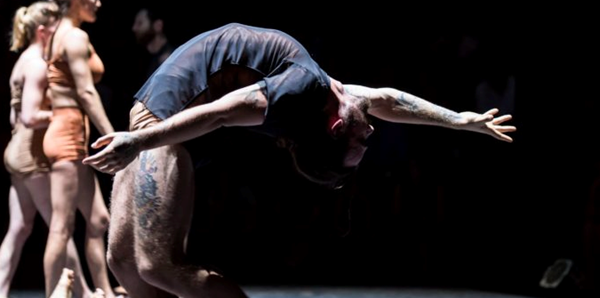
For the first time in its 105-year history, Stravinsky’s seminal masterpiece The Rite of Spring will be reimagined as contemporary circus when Circa stages the world premiere of Rite.
Specially commissioned for Festival 2018 on the Gold Coast, Rite will play from 4 – 8 April at Festival 2018 to celebrate the Gold Coast 2018 Commonwealth Games. Rite is a creation that unleashes the primal energy that runs through us all. See bodies hurl, flow, twist, pulse and collide in an ecstatic tribal circus ritual. Seen by over one million people in 39 countries, Circa is at the forefront of contemporary circus globally – pioneering how extreme physicality can create powerful and moving performances.
A Note from Yaron Lifschitz, Director of Rite and Artistic Director of Circa
Rite is a powerful acrobatic setting of The Rite of Spring driven by the primal energy of Stravinsky’s score. It’s 35 minutes of bodies ricocheting, cascading and doing very intense things to the score of Stravinsky’s pulsating, tribal ritual music, which was originally written for ballet.
Circus adds a level of extreme physicality far beyond what dancers can do. These are ferociously committed acrobats performing like they’re about to die. Essentially their pain is your pleasure.
We tend to think of ourselves as a civilised culture but The Rite of Spring proves we are far more animal than anything else. Forces of nature run through us, shape us and connect us as a species. For me, that’s what Rite is about at its core, and it’s thrilling to be confronted with that. – Yaron
Listen to the complete Rite of Spring
A Quick History on the Rite of Spring

It was over 100 years ago that Rite of Spring premiered at the Théâtre des Champs-Élysées in Paris, 29 May 1913. The performance was a controversial new score by Igor Stravinsky, set to a ballet performance by the Ballets Russes, choreographed by Vaslav Nijinsky. In the 21st century, Stravinsky’s score is considered his most ambitious work, cementing himself as a revolutionary composer who pushed the boundaries of rhythmic structure and musical design. However, the score has achieved legendary status for another reason – it practically started a riot when it first opened.
While there is no official documentation or wholly reliable account of what happened in the evening, the consensus is that on its premiere the music and ballet evoked a sensational reaction in the audience. Tensions were running high among the creation process, with Stravinsky famously disliking Nijinsky and his choreography, conductor Pierre Monteux and the orchestra disliking Stravinsky’s music, and Ninjinsky struggling to work with his dancers. Regardless, the piece was initially received well in-house by invited press and members of the company, and was on track to open on schedule.
It was on its premiere when the reception turned sour – within the first few moments of the piece beginning, laughing broke out among the audience, quickly followed by jeers and booing. The new direction in both dancing and music, which incorporated violent and complicated patterns, and irregular timing and rhythms, were difficult to receive and were rejected by members of the audience. In retaliation, members of the audience supporting the work began shouting back which resulted in a cacophony of protests that virtually drowned out the music. Monteux and his orchestra were instructed to play on regardless of what had happened, and Ninjinsky famously leapt onto the stage and shouted the bar numbers to keep the dancers moving. Stravinsky himself became despondent and retreated from the seats into the stage wings, where he watched the rest of the performance.
While the reception might’ve been considered a failure, the show as a financial success, and the controversy it has elicited had elevated the Rite of Spring to instant fame. The work was performed another five times its season, and while it retained its air of controversy there were no more disturbances during the season.
Rite of Spring in Modern Times

After the opening in Paris, The Rite of Spring went on to have a season in London before lying dormant until after the first world war. The work had its first premiere in the United States in 1930, and then had an acclaimed reaction to a season at La Scala in Milan in 1948.
The work has been reinterpreted through history by many notable companies, including at 1975 re-staging by Pina Bausch, legendary director Paul Taylor, and a reconstruction of Ninjinksy’s original choreography in 1987 by the Joffrey Ballet in 1987.
Perhaps most famously is the interpretation by Walt Disney, who brought the music to the big screen in his work Fantasia in 1940, although the depiction of dinosaurs and lava were a slight departure from the storyline.
In 2008, The Australian Ballet and Bangarra Dance Theatre presented an interpretation, in which the Aboriginal perceptions of the elements are seen presented on stage. The 2018 staging by Circa is the first time the music has been interpreted in its entirety through the medium of circus.
Rite by Circa – See it this April
Created by Yaron Lifschitz with the Circa Ensemble
Director Yaron Lifschitz
Lighting Design Jason Organ
Costume Design Libby McDonnell
Developed for the 10-metre deep Roundabout Stage at Broadbeach, Rite is a creation in Festival 2018, 12 action-packed days of culture taking over the Gold Coast from 4-15 April to celebrate GC2018. See Rite from 4 – 8 April – for full program details visit Rite at Festival 2018.
Keep up to date with our complete tour schedule here, or follow our journey on social media and contribute your own stories by using the hashtag #circacircus.
